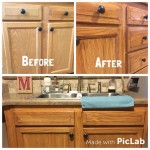How To Organize a Corner Cabinet Without a Lazy Susan
Corner cabinets, particularly those lacking a Lazy Susan, present a significant organizational challenge in many kitchens. Their awkward shape and limited accessibility can lead to wasted space and a frustrating search for stored items. However, with a strategic approach and the right tools, these often-underutilized spaces can be transformed into efficient and functional storage areas.
Effective corner cabinet organization requires a shift in mindset from simply shoving items into the space to thoughtfully considering usage patterns and maximizing available volume. This restructuring involves several key steps, from initial assessment and decluttering to implementing optimized storage solutions.
1. Assessing and Decluttering the Corner Cabinet
The first step in organizing any storage space is a thorough assessment and decluttering process. This involves completely emptying the corner cabinet, carefully examining each item, and making decisive choices about what to keep, donate, or discard. This ensures that only essential and frequently used items occupy valuable cabinet space.
Begin by removing all contents from the corner cabinet. Place items on a nearby countertop or table, creating a clear workspace. As items are removed, take note of the types of items typically stored in the cabinet. This information will be crucial in determining the most effective storage solutions.
Examine each item for its condition and usage frequency. Discard any broken, expired, or unused items. For items that are still usable but no longer needed, considering donating them to a local charity or organization. Be ruthless in this process; the goal is to eliminate clutter and maximize usable space.
Once the decluttering process is complete, clean the interior of the corner cabinet. Wipe down the shelves and walls with a damp cloth to remove dust and debris. Allow the cabinet to dry completely before proceeding to the next step. This ensures a clean and hygienic environment for stored items.
After cleaning, take accurate measurements of the interior dimensions of the corner cabinet. Note the height, width, and depth of the cabinet, as well as the dimensions of any shelves. These measurements will be essential when selecting appropriate storage containers and organizers.
2. Implementing Optimized Storage Solutions
With the corner cabinet empty, decluttered, and cleaned, the next step is to implement optimized storage solutions. This involves selecting and arranging storage containers and organizers that effectively utilize the space, improve accessibility, and maintain organization. Several options are available, each with its own advantages and disadvantages.
Consider using tiered shelves or risers. These allow for vertical stacking of items, maximizing the use of vertical space within the cabinet. Tiered shelves are particularly useful for storing spices, canned goods, and other small items. Ensure that the tiered shelves are sturdy and stable enough to support the weight of the stored items.
Pull-out shelves or drawers offer enhanced accessibility to items stored deep within the corner cabinet. These shelves slide out, allowing for easy retrieval of items without having to reach into the back of the cabinet. Installation of pull-out shelves may require some DIY skills or professional assistance.
Utilize storage containers and bins to group similar items together and prevent clutter. Clear storage containers allow for easy visibility of the contents, while opaque containers can be labeled for identification. Choose containers that are appropriately sized for the items being stored and that fit comfortably within the corner cabinet.
Employ adjustable shelving to customize the storage space to fit specific needs. Adjustable shelves can be moved up or down to accommodate items of varying heights. This allows for efficient use of vertical space and prevents wasted space above or below items.
Maximize unused space by using door-mounted racks or organizers. These racks can be attached to the inside of the cabinet door to store small items such as spices, cleaning supplies, or utensils. Door-mounted racks are a convenient way to keep frequently used items within easy reach.
Consider using wire baskets or mesh drawers for storing produce or other items that require ventilation. These containers allow for airflow, preventing moisture buildup and spoilage. Wire baskets are also lightweight and easy to clean.
When arranging items within the corner cabinet, group similar items together and store frequently used items in easily accessible locations. Place heavier items on lower shelves for stability and safety. Avoid overfilling the cabinet, as this can make it difficult to find items and lead to disorganization.
3. Maintaining Organization and Accessibility
Once the corner cabinet is organized, it is essential to implement strategies for maintaining organization and accessibility over time. This involves establishing routines for putting items back in their designated places, regularly decluttering the cabinet, and adjusting the storage system as needs change.
Develop a habit of putting items back in their designated places immediately after use. This prevents clutter from accumulating and makes it easier to find items in the future. Make it a rule that nothing is left out of place in the corner cabinet.
Conduct a regular decluttering of the corner cabinet every few months. Remove all items and assess their condition and usage frequency. Discard any broken, expired, or unused items to prevent clutter from re-accumulating.
Periodically review the organization system and make adjustments as needed. As storage needs change, consider rearranging items, adding or removing storage containers, or adjusting shelf heights. Adaptability is key to maintaining long-term organization.
Label all storage containers and shelves clearly. This makes it easier to identify the contents of each container and ensures that items are placed back in the correct location. Use a label maker or write labels by hand using a permanent marker.
Consider using a visual inventory system to track the items stored in the corner cabinet. Create a list or diagram of the contents of each shelf or container. This can be helpful for quickly locating items and preventing over-purchasing.
Encourage all members of the household to participate in maintaining the organization of the corner cabinet. Establish clear expectations and guidelines for putting items away and keeping the space tidy. Consistency is essential for long-term success.
Implement a "first in, first out" (FIFO) system for perishable items such as food and spices. Place newer items behind older items to ensure that older items are used first. This helps to prevent spoilage and waste.
Regularly clean the interior of the corner cabinet to prevent dust and debris from accumulating. Wipe down the shelves and walls with a damp cloth every few months to maintain a clean and hygienic environment.
By implementing these strategies, it is possible to transform a challenging corner cabinet into an efficient and functional storage space. Consistent effort and attention to detail are key to maintaining organization and accessibility over time. The result is a more organized and efficient kitchen, where items are easily accessible and clutter is minimized.
Remember to prioritize items that are used most frequently. These should be easily accessible, ideally at eye level or within easy reach. Items that are used less often can be stored on higher or lower shelves.
The specific organizational solutions that work best will depend on the individual needs and preferences of the user. Experiment with different storage containers, organizers, and arrangements to find the system that is most effective. The key is to create a system that is sustainable and easy to maintain over time.
Ultimately, organizing a corner cabinet without a Lazy Susan is about maximizing space, improving accessibility, and maintaining order. By following these steps, it is possible to transform a challenging storage space into a functional and efficient area of the kitchen.

Organizing Pots And Pans In A Corner Cabinet Smallish Home

5 Lazy Susan Alternatives Superior Cabinets

How To Deal With The Blind Corner Kitchen Cabinet Live Simply Method

How To Deal With The Blind Corner Kitchen Cabinet Live Simply Method

How To Organize Corner Kitchen Cabinets The Homes I Have Made

How To Deal With The Blind Corner Kitchen Cabinet Live Simply Method

5 Lazy Susan Alternatives Grandior Kitchens Baths Closets

How To Deal With The Blind Corner Kitchen Cabinet Live Simply Method

Let S Remove The Lazy Susans And Build Shelves My Perpetual Project

Iheart Organizing Organized Kitchen Corner Cabinet With A Diy Lazy Susan
Related Posts








